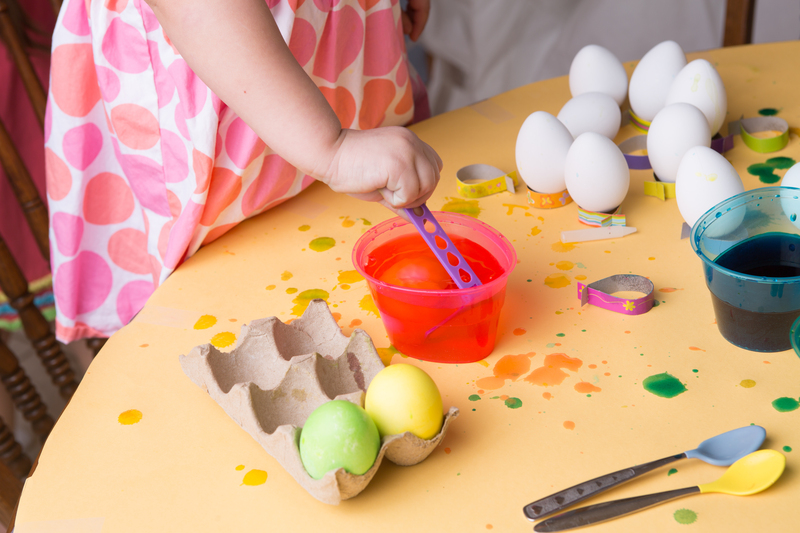Discover the science behind efficient window cleaning techniques
Posted on 07/06/2025
Discover the Science Behind Efficient Window Cleaning Techniques
Cleaning windows may seem straightforward, but achieving a spotless, streak-free finish actually relies on a combination of chemistry, physics, the right tools, and best practices. If you've ever wondered why some cleaning efforts leave behind stubborn streaks or why professional window cleaners achieve crystal-clear results every time, it's time to discover the science behind efficient window cleaning techniques. In this comprehensive guide, we'll explore the principles, products, and methods that empower you to clean windows more effectively--whether at home or on a commercial scale.

Why Window Cleaning Goes Beyond Just 'Wiping Glass'
At its core, efficient window cleaning is all about understanding the interaction between dirt, glass, and cleaning agents. Glass may look smooth, but on a microscopic level, it is pitted with tiny pores and imperfections that can trap dust, oils, and mineral deposits. Rain, pollution, fingerprints, and airborne contaminants all contribute to dirty windows, making cleaning a little more complex than just using soap and water.
The Chemical Science of Window Cleaning
- Surfactants and Detergents: The active components in many glass cleaners, surfactants lower the surface tension of water, allowing it to spread evenly and lift dirt more effectively from the glass.
- pH Levels: An understanding of pH is crucial; most window cleaning products fall within a neutral to slightly alkaline range (pH 6-9) for safe, effective removal of grime without damaging the glass or window seals.
- Solvents: Alcohol and ammonia are common in commercial solutions because they help dissolve oily fingerprints and evaporate quickly, reducing streaks.
- Deionized Water: Professional cleaners often use purified, deionized water that won't leave mineral spots, making for a pristine finish on large commercial windows.
Physics at Work: Why Streaks Happen
Understanding the physical properties of glass and cleaning liquids is essential to mastering efficient glass cleaning. Streaks typically occur due to:
- Incomplete residue removal,
- Poor product evaporation,
- Improper technique, or
- Incorrect tools.
Water with impurities (like minerals) and excess cleaning product not wiped away can dry unevenly, leaving visible marks. The choice and condition of your squeegee or microfiber cloth also significantly influence the outcome.
Choosing the Right Tools: Maximizing Cleaning Efficiency
In efficient window cleaning, the tools matter just as much--if not more--than the cleaning solutions. Let's unpack why:
1. Microfiber Cloths: Science in Fabrics
- Microfiber consists of synthetic fibers much smaller than human hair, creating more contact points for picking up dirt and providing capillary action that absorbs water exceptionally well.
- Unlike paper towels or cotton rags, microfiber traps particles rather than pushing them around, and minimizes lint residue.
2. The Squeegee Advantage
- A high-quality rubber blade squeegee physically removes water and dissolved dirt from the glass, leaving no solution behind to evaporate and create streaks.
- The angle and pressure with which you use the squeegee can dramatically affect the final result.
3. Extension Poles & Water-Fed Systems
- On large panels or high-rise buildings, telescoping poles and water-fed brushes paired with purified water ensure a thorough, even clean without ladders or scaffolding.
- Water-fed poles deliver deionized water to the surface, rinsing away debris and leaving glass spotless--no drying required.
The Best Window Cleaning Solutions: DIY and Professional Options
Not all cleaning products are created equal. The best window cleaning techniques often start with the right solution:
Homemade Window Cleaners: Safe and Effective?
- Vinegar Solution: Mix equal parts distilled white vinegar and distilled water. The acetic acid in vinegar helps dissolve mineral deposits and cuts through greases.
- Dish Soap Solution: One to two drops of grease-cutting dish soap in a gallon of warm, soft water. This breaks down oils but must be rinsed or squeegeed thoroughly to prevent filmy residue.
- Alcohol-Based Sprays: Adding isopropyl alcohol to your mix accelerates drying and reduces streak risk.
Commercial Window Cleaning Products
- Ammonia-based cleaners are effective on greasy or smoke-stained windows but should not be mixed with bleach or used on tinted films.
- Non-toxic, eco-friendly options also exist, based on plant surfactants and biodegradable compounds.
Pro Tip: Always use distilled or deionized water in your mixtures, especially in hard water areas, to prevent mineral spotting!
The Step-by-Step Science of Efficient Window Cleaning
Time to put science into practice! Follow these steps for the most efficient and effective window cleaning:
- Dust and Dry Wipe First: Remove surface dust, cobwebs, and loose dirt with a dry microfiber cloth or soft brush. This reduces smearing during wet cleaning.
- Prepare Your Solution: Use a fresh, clean bucket and mix your chosen cleaner per the instructions. Soft, distilled or deionized water is best!
- Wash with Microfiber or Sponge: Apply solution with a damp microfiber pad or sponge, working from top to bottom to let gravity assist.
- Squeegee Like a Pro: Start at the top of the glass. Hold the squeegee at a slight angle, pull horizontally or in an "S" pattern, and wipe the blade after every pass.
- Detail the Edges: Use a dry, clean microfiber cloth to wipe window edges and sills, catching any drips or remaining streaks.
- Polish to Finish: For added shine, buff the glass with a clean, dry microfiber towel, working in small circles.
Bonus Science Tips for Streak-Free Results
- Never clean windows in direct sunlight; quick evaporation causes streaks.
- Work on cloudy days or early/late hours.
- Change your cleaning solution and cloths frequently to prevent dirt redeposition.
- If your water is hard (full of minerals), prioritize using distilled or deionized water.
Environmental Factors Impacting Window Cleaning Efficiency
Certain conditions can dramatically impact the effectiveness of your window cleaning techniques:
Weather and Temperature
- On hot days, cleaning solution evaporates quickly, making it harder to achieve a streak-free finish.
- Cold conditions can cause cleaning fluids to freeze or dry poorly, leaving residue.
Location and Exposure
- Urban buildings may experience more pollution, requiring stronger detergents or more frequent cleaning.
- Coastal areas may struggle with salt spray and mineral deposits, calling for specific cleaning routines.
Technological Innovations in Window Cleaning
The science of window cleaning is constantly evolving thanks to new materials and devices:
Robot Window Cleaners
- Modern window-cleaning robots use suction, sensor mapping, and motorized cleaning pads to automate glass maintenance.
- While convenient, results often require a manual finish for perfection.
Water-Fed Pole Systems
- Increasingly popular for tall buildings, these use telescoping poles delivering purified, deionized water directly to the glass, scrubbing and rinsing in one step.
- This technology removes the need for squeegees or drying, leveraging water chemistry for spot-free drying.
Nanotechnology and Protective Coatings
- Nanocoatings can bond to glass surfaces, making them hydrophobic--water beads up and rolls off, carrying dirt away.
- Such coatings reduce the frequency of cleaning and can make future dirt easier to remove.
Common Mistakes That Hinder Window Cleaning Efficiency
Even when armed with the right knowledge, the following missteps can sabotage your window cleaning efforts:
- Using too much cleaning solution--more doesn't mean better and can leave a filmy residue.
- Employing dirty cloths or tools, which simply redeposit grime.
- Cleaning during direct sunlight or extreme temperatures--as discussed, this leads to streaks.
- Not rinsing sills and frames, which can cause dirt to drip onto freshly cleaned glass.
Expert Secrets: How Pros Achieve Crystal-Clear Glass Every Time
Professional window cleaners rely on a blend of science, experience, and technique. Here are some insider tips:
- Sequence matters: Always start at the top and work your way down, letting gravity help you.
- Customize solutions for specific grime: Greasy fingerprints and mineral stains may need targeted products.
- Change the squeegee blade often: A nicked or worn blade causes streaks.
- Routine matters: Frequent, gentle cleans prevent buildup, making every future cleaning easier and more efficient.

FAQs: Understanding Efficient Glass Cleaning Techniques
-
How often should windows be cleaned?
Ideally, residential windows should be cleaned twice a year, while commercial properties may benefit from quarterly or even monthly cleaning. -
Is vinegar safe for all types of windows?
Vinegar is safe for plain glass but avoid it on tinted, coated, or acrylic windows, as the acid can damage finishes or films. -
What's the best way to clean high or hard-to-reach windows?
If possible, use extension poles with microfiber pads or invest in a water-fed pole system. Never risk safety--consider professional help for multi-story cleans. -
Can newspaper be used for window cleaning?
While old advice touted this method for its polishing qualities, modern newspaper ink may smudge or transfer to the glass. Microfiber is safer and cleaner.
Conclusion: Turning Science Into Sparkling Success
Efficient window cleaning is both an art and a science. By understanding the chemistry of cleaning solutions, the physics of streak prevention, and leveraging the most advanced tools and techniques, anyone can enjoy gleaming, streak-free windows at home or at work. Remember, the secret is equal parts preparation, execution, and attention to environmental conditions. Ready to discover the science behind efficient window cleaning and enjoy clear results every time? Put these expert-backed strategies into action and elevate your window cleaning game today!





